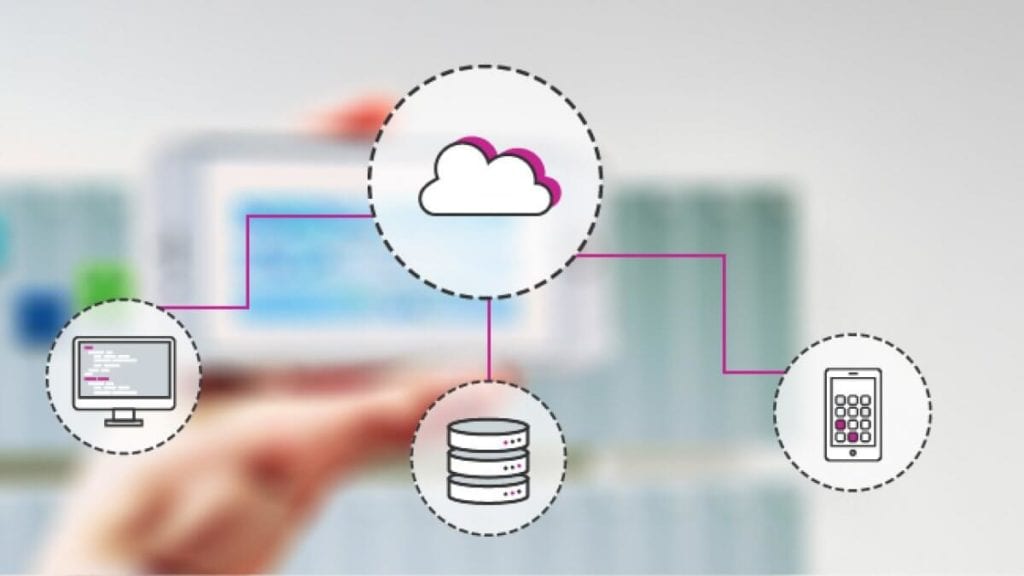Imagine the situation: you have just bought a new apartment. No doubt, this fantasy can make you feel happy immediately. But once you elaborate on this idea, you meet a little fly in the ointment: relocation. Specifically, you need to take all the furniture, interior decorations, and vibe of your apartment and shift them to another space, fast and unchanged. For that, you can hire an entire moving company, an individual removal porter, or decide to do everything by yourself. No matter what you choose, you’ll inevitably need to do that somehow.
If to simplify the idea of application migration to maximum, that’s the process of relocation.

What Is Application Migration?
In essence, applications migration means transferring the existing software from one computing environment to another. Under the computing environment, you can mean different things:
- Laptop,
- Data center,
- Server,
- Cloud,
- Scanners and printers,
- ... or the smart home network, if to get back to the relocation example.
Even though the notion of “software transferring” sounds lighter than the physical relocation of furniture and large-scale paintings, it still possesses some difficulties. You’ll need the strategic vision, action plan, project thinking, and accurate testing to make things right.
Application Migration Strategy
To implement application migration wisely, think of several things in advance. Your starting environment and target environment are different, especially in terms of safety and compliance requirements. If you neglect these problems from the get-go, you'll get extra problems and expenses as a result.
In our relocation analogy, your new living room may have different positions of windows and doors, another floor covering, or smaller area. And you need to adjust the old composition to these new rules. If you paid attention to superficial problems only, the new complexities would surprise you every day. For example, it can be an outdated signalizing or neighbors with small children who will surely hate your hip-hop music at 11 PM. You need to consider all these complications to protect yourself from thieves or project slowdown.
A good action plan of application migration strategy includes 2 spheres:
- Fitting the specifics and technological requirements of each application to a new system,
- Managing the concerns of the new computing system, including corporate security, compliance constraints, and budget limitations.

Application migration steps: Strategic milestones
- Determine the application’s portfolio
- Define security and compliance requirements
- Outline the cloud resources already used
- Explain the state of the current computing system, including the existing on-premises storage and network infrastructures
- Think of mitigating the risks, meaning unforeseen technological challenges, unanticipated costs, unexpected downtime, and cross-cultural issues.
3 Stages of an Application Migration Plan
- Identify and assess all your applicationsAt this stage, the initial discovery and application portfolio creation happens. You need to categorize each feature in your starting computing system based on their business and strategic value. In particular, aim at identifying overall business impact, capacity to meet the business needs, data importance, complexity and ability to control an application, its maintenance cost, and potential after migration. This will help to understand how complex your application migration will be.
- Evaluate the total cost of ownershipAfter you collected all the possible scenarios of application migration, determine your budget. Take account of purchasing, operation, and maintenance costs for each scenario to create the most comprehensive picture possible. Don’t forget to include the spending on testing and training to use the new software if needed.
- Create a project planProvide the sustainable ground to create an application migration project plan based on the research and calculation you’ve made. In particular, evaluate the overall risk and timeline.
Application migration checklist: How to evaluate each application?
- Level of complexity: who developed, where are the documents, what’s the application’s age, how important it is for the network,
- Criticality: how important is the application for users, where is it used (production, development, testing), who manages, is it synchronized with other applications,
- Compliance requirements,
- Is it a subject to a service level agreement (SLA)?
Application Migration Project Plan
The best way to exercise application migration is to plan it as a project. In this case, you’ll set the measurable aims, including the exact schedule and budget limits. Don’t neglect the importance of comprehensive planning and attention to detail here.
From the get-go, identify the age of your software. The older technologies you use, the more costly and prolonged your project will be. Moreover, age affects the legacy application migration.

What Are the Common Types of Application Migrations?
Depending on the nature of computing environments, application migrations have 4 types:
- Between cloud environments,
- Between data centers,
- From a public cloud to a private/hybrid cloud,
- From an on-premises data center to a cloud.
Particular attention deserves application migrations to cloud. Although there are numerous subcategories for this type, they’re easy to remember: all the strategies start with the letter “R.” That’s why they have got an alternative “The 6R’s” title.
- Rehosting (or “lift-and-shift”)This case is relevant for a large legacy shift. In this case, you can do the exact migration quickly and save time for optimizing and architectural adjustments. The process happens between an on-premises server and a cloud-based virtual machine.
- Refactoring (or “lift, tinker, and shirt”)In the situation of refactoring, the severe changes to an application are already needed. It can take a form of recoding major parts or making some slight adjustments. For example, you can re-architect the monolithic software into the set of several microservers. All this transformation is used to adapt the application to the cloud native computing environment.
- Replatforming (or revision)In essence, this type of cloud computing means slightly changing non-critical applications. Restructuring is needed when rehosting is too little and refactoring is too much. Nevertheless, such changes to the application code require expert knowledge in how your application works and how it should be optimized for the cloud.
- Retire (or rebuild)When the application migration task is too hard, the application needs fundamental decomposition. In this case, retire can increase the software's value by eliminating duplicated features and creating an entirely new offering of the SaaS platform. In this case, the developers should rethink the application's key process: its workflows, integration, and main components.
- RetainThis measure is like redecorating a house. Some options are not the subject of applications migration, and you simply leave them as they are. At a certain point in the future, you can take them to your new computing environment. Technically, it’s not a migration application but a demonstration of its successful strategizing and planning. With a comprehensive approach, you will inevitably see that not everything you had before is needed in the new computing system.
- Repurchasing (or replace)In this case, you ask a third party to move your computing environment to a SaaS platform. It saves your in-house team from managing infrastructure and covering maintenance problems. This third-party application should have the functions and capabilities relevant for your application but with necessary compliance to cloud requirements.

Application migration testing
In the case of application migration, testing ensures that no information or critical features are lost during the transfer. This stage also validates the integrity of your computing system in the target environment and the correct location of each element.
What is application migration process?
Determined as a process, application migration means moving software applications to the new environment. Mostly, it refers to taking business advantages of switching to cloud platforms, including better control over corporate finances, higher responsiveness, and faster updates.
How long does application migration schedule
The exact timeline of your application migration depends on your software's age and complexity and the specifics of the target environment. Approximately, it takes around 4 months, but this number is very generalized.
Application migration best practices
Here’s the list of the most successful cases of application migration.
Assess the application and environment
The precise calculation and description of all the available assets is what an ideal assessment is. At this stage, the most important task is not to overlook the important details that may cause severe problems in the future. Given the equal value of the application and environment specifics for application migration strategy, it’s crucial to develop both these elements' detailed assessment.
The comprehensive assessment of an application includes IT infrastructure analysis, legacy limitations, and problematic internal dependencies for data migration. The environment analysis should mention compliance standards, scalability issues, and business practices.
Create a deployment document
Another great way to present the assessment of application and environment is to create a deployment document. A well-done report includes these parts:
- An inventory list of all the servers, applications, and supporting technologies available,
- The catalogue of network specifications, including connections and dependency bonds between applications,
- Statistical data on the application performance (especially about the demand it serves),
- The presentation of all the possible problems that need to be addressed during application migration.
While developing a deployment document, pay attention to particular server settings and dependencies. This will save your team's time and effort in the latter stages of software testing and maintenance.
Also, create measurable KPIs. They are important for the successful application migration project performance. Moreover, KPIs assist in monitoring day-to-day activities and taking needed measures to eliminate possible issues in advance.
Prepare for data migration
The best preparation is creating a backup of the complete file you’re about to transfer in simple terms. To facilitate your work with this Masterfile in the future, make the folder paths, document titles, and usernames similar.
The more complex preparation for data migration includes application performance monitoring. In this case, you should configure necessary analytical tools to track and ensure your application migration project's success. In the case of migrating data to the cloud environment, we recommend paying attention to these application migration services:
- Google Cloud,
- Pivotal,
- Salesforce,
- Amazon Web,
- Microsoft Azure.
By choosing any of them, you can combine the application performance monitoring with better control over your system resources.
Another important aspect of preparation is ensuring compliance monitoring and validation. This means getting extra control over data migration for the business serving highly strict and regulated industries (governmental, for example). The compliance regulations here are stricter and can be unpredictable. And so, the stage of data migration is to check whether the applications are ready for the changes and challenges the target computing environment will bring.
Here are 3 most common compliance challenges:
- PCI DDS (Payment Card Industry Data Security Standard) — appears when your users need to mention their credit card details,
- HIPAA (Health Insurance Portability and Accountability Act) — appears when your patients need to mention their sensitive health data,
- GDPR (European General Data Protection Regulation) — appears when your visitors need to mention the details of their EU citizenship.

Restore and reconfigure
At this stage, your task is to reconfigure your application in the new computing system. In practice, this is like unpacking your baggage in a hotel room. You will determine the related files and rediscover paths and connection strings to accommodate your new environment's applications.
Automate when possible
The proper optimization of automation migration is also one of the best practices. In this case, your task is to limit disruption, save time, and boost your migration effectiveness. Usually, you can find space for automation in repetitive patterns. Look for opportunities in your experience on the previous stage to facilitate your work during the next steps.
Create a test plan
Creating a testing strategy is important for application migration. For an effective test, use your local environment as the needed playground: modify the hosts files on your computer before appearing with the change at the destination server. Your ability to have fresh eyes is important here: seeing your application as a user and/or server administrator guarantees the best testing practice.
How to manage an IT application migration project
If you need comprehensive application migration, we recommend hiring a professional team who can perform this task as an IT project. We in Intellectsoft offer this service to our clients, and we’ll be glad to assist you in this too. If you’re ready to let us manage your IT application migration project, please contact us.